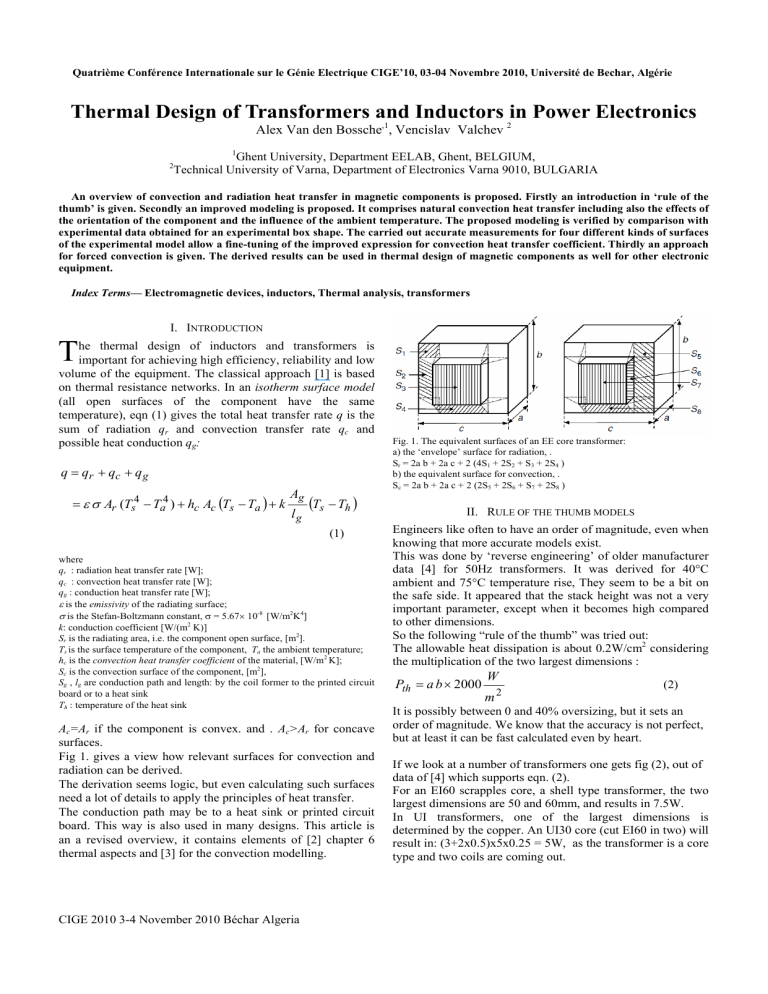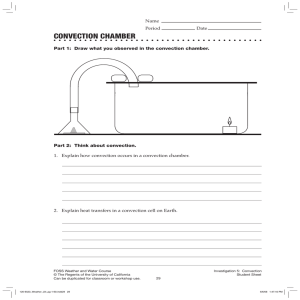
Quatrième Conférence Internationale sur le Génie Electrique CIGE’10, 03-04 Novembre 2010, Université de Bechar, Algérie
Thermal Design of Transformers and Inductors in Power Electronics
Alex Van den Bossche,1, Vencislav Valchev 2
1
2
Ghent University, Department EELAB, Ghent, BELGIUM,
Technical University of Varna, Department of Electronics Varna 9010, BULGARIA
An overview of convection and radiation heat transfer in magnetic components is proposed. Firstly an introduction in ‘rule of the
thumb’ is given. Secondly an improved modeling is proposed. It comprises natural convection heat transfer including also the effects of
the orientation of the component and the influence of the ambient temperature. The proposed modeling is verified by comparison with
experimental data obtained for an experimental box shape. The carried out accurate measurements for four different kinds of surfaces
of the experimental model allow a fine-tuning of the improved expression for convection heat transfer coefficient. Thirdly an approach
for forced convection is given. The derived results can be used in thermal design of magnetic components as well for other electronic
equipment.
Index Terms— Electromagnetic devices, inductors, Thermal analysis, transformers
I. INTRODUCTION
T
he thermal design of inductors and transformers is
important for achieving high efficiency, reliability and low
volume of the equipment. The classical approach [1] is based
on thermal resistance networks. In an isotherm surface model
(all open surfaces of the component have the same
temperature), eqn (1) gives the total heat transfer rate q is the
sum of radiation qr and convection transfer rate qc and
possible heat conduction qg:
q = q r + qc + q g
= ε σ Ar (Ts4 − Ta4 ) + hc Ac (Ts − Ta ) + k
Ag
lg
(Ts − Th )
(1)
where
qr : radiation heat transfer rate [W];
qc : convection heat transfer rate [W];
qg : conduction heat transfer rate [W];
ε is the emissivity of the radiating surface;
σ is the Stefan-Boltzmann constant, σ = 5.67× 10-8 [W/m2K4]
k: conduction coefficient [W/(m2 K)]
Sr is the radiating area, i.e. the component open surface, [m2].
Ts is the surface temperature of the component, Ta the ambient temperature;
hc is the convection heat transfer coefficient of the material, [W/m2 K];
Sc is the convection surface of the component, [m2],
Sg , lg are conduction path and length: by the coil former to the printed circuit
board or to a heat sink
Th : temperature of the heat sink
Ac=Ar if the component is convex. and . Ac>Ar for concave
surfaces.
Fig 1. gives a view how relevant surfaces for convection and
radiation can be derived.
The derivation seems logic, but even calculating such surfaces
need a lot of details to apply the principles of heat transfer.
The conduction path may be to a heat sink or printed circuit
board. This way is also used in many designs. This article is
an a revised overview, it contains elements of [2] chapter 6
thermal aspects and [3] for the convection modelling.
CIGE 2010 3-4 November 2010 Béchar Algeria
Fig. 1. The equivalent surfaces of an EE core transformer:
a) the ‘envelope’ surface for radiation, .
Sr = 2a b + 2a c + 2 (4S1 + 2S2 + S3 + 2S4 )
b) the equivalent surface for convection, .
Sc = 2a b + 2a c + 2 (2S5 + 2S6 + S7 + 2S8 )
II. RULE OF THE THUMB MODELS
Engineers like often to have an order of magnitude, even when
knowing that more accurate models exist.
This was done by ‘reverse engineering’ of older manufacturer
data [4] for 50Hz transformers. It was derived for 40°C
ambient and 75°C temperature rise, They seem to be a bit on
the safe side. It appeared that the stack height was not a very
important parameter, except when it becomes high compared
to other dimensions.
So the following “rule of the thumb” was tried out:
The allowable heat dissipation is about 0.2W/cm2 considering
the multiplication of the two largest dimensions :
Pth = a b × 2000
W
m2
(2)
It is possibly between 0 and 40% oversizing, but it sets an
order of magnitude. We know that the accuracy is not perfect,
but at least it can be fast calculated even by heart.
If we look at a number of transformers one gets fig (2), out of
data of [4] which supports eqn. (2).
For an EI60 scrapples core, a shell type transformer, the two
largest dimensions are 50 and 60mm, and results in 7.5W.
In UI transformers, one of the largest dimensions is
determined by the copper. An UI30 core (cut EI60 in two) will
result in: (3+2x0.5)x5x0.25 = 5W, as the transformer is a core
type and two coils are coming out.
Quatrième Conférence Internationale sur le Génie Electrique CIGE’10, 03-04 Novembre 2010, Université de Bechar, Algérie
Fig 2. Observed total losses of 50Hz transformers, depending on the largest
dimensions
Normally, one would think that small 50Hz transformers cool
better in convection than larger ones. The reason why it is not
the case in practice is that the copper losses in small
transformers are much higher than the iron losses. This results
in a much higher copper temperature. and so the average heat
loss removal is reduced. If the transformer is impregnated, the
thermal resistance between copper and iron gets better and the
internal temperature drop in copper reduces, allowing 20-30%
more heat removed from the copper.
In ferrite transformers, the ratio of copper to iron loss may
vary a lot, so the analysis is less easy.
Another way is using information on thermal resistances given
by manufacturers as [5] “bell transformers”
(3), the convection heat transfer is estimated with some
inaccuracy of 20…30%. This fact results in poor prediction of
the component temperature rise. Magnetic components have
similar shapes, but they are never ‘infinite or thin plates’. So,
the heat transfer coefficient hc could be well defined, but still
different from the classical thermal approach for horizontal
and vertical plates.
This part presents a study about natural convection and
convection heat transfer coefficient hc. The results are relevant
in the design of magnetic components for power electronics
and other equipment.
B. Experimental set-up
To find a more precise expression for the coefficient hc ,
equilibrium temperatures of an experimental model were
measured under different conditions and different type of its
surfaces. A box or brick type shape was used with dimensions
42/42/15 mm, which are the outer dimensions of an EE42
core.
The experimental model was made from copper, 1mm
thickness.
Copper
tubes
Heating
resistors
NTC
III. MORE PRECISE ANALYSIS
A. Usual models
The coefficient hc in the expression (1) for convection heat
transfer is quite critical. Most authors [6,7] give present the
following simplified expression for it as a function of the
height L of the component:
⎛ ΔT ⎞
hc = C ⎜
⎟
⎝ L ⎠
a)
1/ 4
where C=1.32...1.42
∆T is the temperature rise, ∆T = Ts – Ta [K];
L is the height of the component, [m], in classical theory L
is a characteristic dimension equal to the height of an infinite
vertical surface.
For magnetic components the values of hc are in the range
hc = 6...10 W/(m2 K) for a temperature rise of ∆T=50K.
[6, 7]
The expression (3) is only valid under specific conditions,
which limit its validity for magnetic component design:
• Convection heat transfer is a quite complex process and
the expression (3) derived for infinite surfaces is not
completely applicable for magnetic components.
• The conductivity, viscosity and density of air are assumed
to be constant in the temperature range, where the
expression is used, which is only an approximation.
• Expression (3) is not valid for natural convection in an
enclosed space or in close proximity of other heated
surfaces. Usually the ‘ambient temperature’ is adapted to
some inside average temperature in the enclosure.
As a result of the above mentioned limitations of expression
CIGE 2010 3-4 November 2010 Béchar Algeria
Copper
tubes
(3)
NTC
b)
Fig.3 A sketch of the experimental model.
a) transparent view
b) side cross section
The temperature was measured by NTC thermistors, type
JR203R5, with the nominal resistance 20kΩ at 20°C. The
NTC’s were mounted on the inner surface of the model (see
Fig.1). Care was taken to realise good thermal contacts and to
avoid cooling the sensors by the wires.
The heating of the model was realised by two heating
resistors (2 x 5W), put with silicone paste in copper tubes with
Quatrième Conférence Internationale sur le Génie Electrique CIGE’10, 03-04 Novembre 2010, Université de Bechar, Algérie
an outer diameter of 10mm, 22mm long, 0.5mm thickness,
which were soldered inside the model. The model is close to
an isothermal surface model because the thermal conductivity
of copper is quite high.
To avoid the influence of the air current in the room, the
models were put in a box open at the top with dimensions
220mm by 220mm on 300mm high. As a supporting element,
a thin iron wire was used and the model was kept in a chosen
distance (10mm…100mm) above the bottom of the box.
To convert the measured resistance values Rmeas in
temperature (Tmeas) the following model of the thermistor
characteristic was used:
Tmeas =
B
− Tb
R meas
B
ln
+
20000 Tb + 25
(4)
The values of the parameters Tb and B were adapted to fit
the data provided by the NTC manufacturer and the results of
the calibration of the NTC’s. Thus, the found values for the
used NTC’s are: B = 5102, Tb = 316. The resistivity of the
NTC’s was checked by finding their resistance for 0°C and
100°C. The deviations of the temperature values calculated by
model given by equation (4) and the nominal values given in
the data of NTC’s are less than 0.4K.
The experiments were carried out in ambient temperature in
the range of 25…27°C. The results were corrected
(normalised) to 25°C, taking in account the difference in
radiation heat transfer for different ambient temperatures. All
the measurements were repeated several times and the
differences between the different measurements are below
0.3K, which proves a sufficient repeatability of the
experiment. Without box open at the top, one obtains a cloud
at low power levels, the natural convection is influenced by
small air movements in the room.
C. Thermal measurements
The aims of the experiments carried out with the box type
model were to collect enough data in order to derive a more
precise expression for the convection heat transfer coefficient
hc. The measurements were done with four different surfaces
of the model:
- New but unpolished copper, which is the original surface
of the model;
- Enamelled copper, which is the real open surface of
windings;
- Black painted surface, which has the emissivity close to
the emissivity of transformer iron and ferrites;
- Bright aluminium covered model. The model was covered
by a thin aluminium foil.
To find the influence of the horizontal and vertical surfaces
area on the coefficient hc, the measurements were done for
both horizontal and vertical orientation of the model.
The measured results for ambient temperature Ta = 25°C are
shown in Fig.3. The figure represents the dependence of the
temperature rise ∆ T on the dissipated power Pdiss.
CIGE 2010 3-4 November 2010 Béchar Algeria
The bold line represents the dependence ∆T= f(Pdiss) in
horizontal orientation of the model and the light line in
vertical orientation of the model. To find out the convection
heat rate we need the values of the emissivity ε of the
different surfaces.
From Fig.3 we can find the differences between the emissivity
of the surfaces because the convection heat transfer is the
same for the same temperature rise (assuming the same
Fig.4 Temperature rise ∆T as function of the dissipated power Pdiss for
different surfaces, box 42x42x15mm, bold curves: horizontal orientation of
the model; light curves: vertical orientation of the model.
(note that the light curves are just below the bold curves)
1: bright aluminium; 2: unpolished copper; 3: enamelled copper 4: black
painted copper.
ambient temperature). The results are corrected (normalized)
to 25 °C ambient temperature, during the measurements the
ambient temperature was in the range 25…27 °C.
The difference ∆ε between the emissivity of any two surfaces
is:
Δε = ε 1 − ε 2 =
Δqr
Aσ ( Ts4 − Ta4 )
(5)
where
Ts : measured temperature of the radiating surface;
Ta : ambient temperature;
∆qr = qr1 –qr2is the difference in the radiation heat rate of the
compared surfaces; in the case ∆qr is the difference in the
dissipated power for one and the same ∆T (see Fig.4).
The found differences between the emissivity of the
investigated surfaces are:
∆εbp-en = 0.115 (between black and enamelled surfaces),
∆εen-cu = 0.0.67 (between enamelled and unpolished surfaces),
∆εcu-al = 0.0.07 (between unpolished and aluminium surfaces).
We chose a value of εbp = 0.925 for black painted surface as a
reference value. Then, the emissivity of the other surfaces are:
Enamelled copper:
ε en = ε bp − Δε bp − en = 0.925 − 0.115 = 0.81
Unpolished copper:
ε cu = ε en − Δε en −cu = 0.81 − 0.67 = 0.14
Bright aluminium:
ε al = ε cu − Δε cu −al = 0.14 − 0.07 = 0.07
Quatrième Conférence Internationale sur le Génie Electrique CIGE’10, 03-04 Novembre 2010, Université de Bechar, Algérie
D. Presentation of the convection heat transfer coefficient
A curve fitting was done, based on the widely used
presentation of the convection coefficient hc mentioned in eqn.
(4), where C= 1.32...1.42 , and L is the height of the
component [m]. The results are quite bad matching the
experimental data and theoretical model, both with respect to
the temperature rise and dimensions of the component. The
reason for the bad matching is that the convection process is a
quite complex phenomenon. Properties of air such as heat
conductivity k, kinematic viscosity ν and specific weight
(density) ρ, which influence the convection process, change a
lot in the considered temperature range 250...400K.
TABLE I
PROPERTIES OF AIR: HEAT CONDUCTIVITY K, VISCOSITY ν AND DENSITY ρ IN
THE TEMPERATURE RANGE 250...400 K [2,6]
Temperature,
250
300
350
400
[K]
Conductivity
0.02227
0.02624
0.03003
0.03365
k, [W/m K]
11.31
15.69
20.76
25.29
Kinematic
ν,
viscosity
-6
2
[10 m /s]
1.1774
0.9980
0.8826
Density
ρ, 1.4128
[kg/m3]
Prandtl
0.722
0.708
0.697
0.689
number Pr,[.]
Thus, the heat transfer parameters: Nusselt number Nu,
Grashof number Gr and Rayleigh number Ra, which are used
in classical convection heat transfer theory, are quite
influenced by the temperature and as a result, the simplified
is not observed in the real
proportionality hc ∝ (ΔT / L )
experiment. The definitions for Prandtl number Pr, Grashof
number Gr and Rayleigh number Ra are:
0.25
Pr =
ν
α
Nu = 0.68 +
for Ra< 109
⎞
⎟⎟ (Ts − Ta ) L3
⎠
ν
2
Ra = Gr Pr
(7)
(8)
ν is kinematic viscosity, [m2/s];
α is an accommodation coefficient, [s/m2];
g is the gravity, =9.81m/s2.
The convection coefficient hc is defined by the Nusselt
number Nu as follows:
k
hc = Nu
L
where k is the thermal conductivity.
CIGE 2010 3-4 November 2010 Béchar Algeria
(9)
0.670 Ra 1 / 4
(1 + (0.492 / Pr ) )
9 / 16 4 / 9
(10)
Substituting the different equations in (9), results in the
following expression of hc ; for the temperature dependency of
ν and α, the average between ambient and surface temperature
is used:
1/ 4
⎡
⎧⎪ ⎛ 2 ⎞
⎫⎪ ⎤
3
2
⎢
⎟ (Ts − Ta ) L Pr/ν ⎬ ⎥
0.670 ⎨ g ⎜⎜
⎢
⎪⎩ ⎝ Ts + Ta ⎟⎠
⎪⎭ ⎥ k
hc = ⎢0.68 +
⎥
4
/
9
⎢
⎥L
1 + (0.492 / Pr )9 / 16
⎢
⎥
⎣⎢
⎦⎥
{
}
(11)
From eqn. (11) it is clear that:
the exponent, giving the final dependence of hc on
temperature rise, is lower than 0.25 as Ts , ν, Pr and k are
quite temperature dependant.
• the exponent giving the dependence of hc on the height L
is higher than 0.25 because of the additional term 0.68 in
(9) and (10).
Those conclusions imply the need of more precise values of
the exponents. Considering that facts our investigation aims
were the following:
1. To obtain more precise values of the exponents in a
simplified expression of hc:
•
hc = C
(6)
⎛
2
g ⎜⎜
T s + Ta
Gr = ⎝
where
One precise presentation of the Nusselt number, applicable
over wide range of the Rayleigh number has been provided by
Churchill and Chu [10]:
(ΔT )αT
Lα L
(12)
The exponents αT , αL and the coefficient C are to be found
(note that αT and αL are not equal like in (2)).
2.
To extend the expression (12) and to derive the
dependence of hc on the pressure p, on the ambient
temperature Ta and on the orientation (horizontal or
vertical) of the component, i.e. to define a complete
presentation of hc in the way:
⎛ p ⎞
⎟
hc = C ⎜
⎜ pref ⎟
⎠
⎝
αp
⎛ Ta
⎜
⎜ Ta ,ref
⎝
⎞
⎟
⎟
⎠
α Ta
(ΔT )αT
Lα L
(13)
where the exponents αp and αTa and the coefficient C
Quatrième Conférence Internationale sur le Génie Electrique CIGE’10, 03-04 Novembre 2010, Université de Bechar, Algérie
L = 10 ...400 mm is α L = 0.285 with deviations 4% at
(depending on the orientation) are to be found.
First, using MATCAD and the table I data, we derive the
following analytical expressions:
the end of the range (for comparison, the exponent 0.25
results in deviations above 22% in the considered range).
k = f 1 ( T ), μ = f 2 ( T ), ρ = f 3 ( T ), Pr = f 4 ( T ) ,
which match the corresponding table data very well and the
difference is below 0.1% (μ is dynamic viscosity, ν = μ / ρ ).
Secondly, those expressions are substituted in (11) and we
obtain the complete classical expression for hc:
hc = F ( ΔT ,Ta , L , p )
(14)
Finally, the precise values of the exponents αT , αL, αp and
αTa giving the dependence of hc on the corresponding quantity
and the coefficient C were found. Each exponent was found
individually by comparing the results obtained by (13) and the
results of an expression consisting of an adaptation coefficient
and the corresponding quantity ΔT , Ta , L, p and the wanted
exponent.
For the final modelling of the convection coefficient hc
obtained after the above-proposed approach we propose:
⎛ p ⎞
⎟
hc = C ⎜
⎜ p ref ⎟
⎝
⎠
where
0.477
⎛ Ta
⎜
⎜ Ta ,ref
⎝
⎞
⎟
⎟
⎠
−0.218
(ΔT )0.225
L0.285
(15)
C is: C h = 1.53 for horizontal orientation
and Cv = 1.58 for vertical orientation of the component;
L is the total distance passed by the air cooling the
component (see Fig.5);
ΔT is the temperature rise, ΔT = Ts − Ta , [K];
pref is the reference pressure at the sea altitude;
Ta,ref is the reference ambient temperature, Ta ,ref = 25°C .
A. Proposed dependence of hc on temperature rise
The value found by MATCAD for the exponent αT is
αT = 0.225 . The deviations between the values of hc
αT
calculated by (15) and the expression
are
hc = A1 ( ΔT )
below 0.5% in the range of 10...90K for the temperature rise
∆T (A1 is an adaptation coefficient). The same exponent
αT = 0.225 matches well the results for convection of
vertical and horizontal plates in the considered temperature
range 250...400 K in the software, included to the classical
book of Holman [6].
B. Proposed dependence of hc on the size of the component
The observed dependence for combined vertical and
horizontal surfaces, which is the case of magnetic
components, includes two new aspects:
1. A more precise exponent for L in the considered range
CIGE 2010 3-4 November 2010 Béchar Algeria
Fig.5 Fig.4 Parameter L as the total distance passed by the air cooling the
component:
2.
L =a+b.
The parameter L is the total distance passed by the air
cooling the component (see Fig.5). In general L could be
described as “half of the length of the shortest path around
a vertical mid section of the object”. Notice that L is not
the height of the component. In the box-shape model, for
example the model with EE42 dimensions, the parameter
L = a+b=57mm .
C. Proposed dependence of hc on the orientation of
component
The difference in convection for horizontal and vertical
orientation of a component is proved by the experiments to be
very low. This difference can be presented by different values
of the coefficient C for both orientations. The experimentally
obtained values are: C h = 1.53; Cv = 1.58 , respectively for
horizontal and vertical orientation of the model.
D. Proposed dependence of hc on pressure
The influence of the pressure p on the coefficient hc was
found to be given by the exponent α p = 0.477 . The
deviations are below 0.2% for the range of 50 ... 200% pref .
A similar dependence
hc ∝
p can also be found in [3].
E. Proposed dependence of hc on the ambient temperature
The value found by MATCAD for the exponent αTa is
αTa = −0.218 . The deviations between the values of hc
calculated
by
(14)
and
the
expression
αTa
are below 0.04% in the range of
hc = A2 (Ta / Ta,ref )
0 ~ 120 °C for the ambient temperature rise Ta (A2 is an
adaptation coefficient).
F. Dependence of hc on the shape of the component
Till now we considered only box shape components. For
more complex component shapes an equivalent surface can be
Quatrième Conférence Internationale sur le Génie Electrique CIGE’10, 03-04 Novembre 2010, Université de Bechar, Algérie
used to find the convection heat transfer. This surface is closed
to the envelope surface, which is quite lower than the total
component open surface. For example, for an EE42
transformer (including coil ends) the total open surface is
7.872 × 10 −3[m 2 ] ,
−3
the
‘envelope’
surface
is
2
6.895 × 10 [ m ] and the box surface, corresponding to the
ferrite’s dimensions is 6.048 × 10 −3[ m 2 ] .
The derived expression (14) can be used also in more
complex thermal models including inner thermal resistances
and different copper and iron temperatures, representing the
complexity in the construction details of the component.
E. Comparison of the experimental results and the
convection fit formulae
The experimental results where compared with the analytical
curves obtained by the final fit formulae (14). The
experimental and theoretical curves were matched for
enameled and black painted surfaces of the model. The
matching is quite good as it can be seen in Fig.5 and Fig.6
showing the dependence ΔT = f ( Pdiss ) for ambient
temperature Ta = 25°C and proves the validity of the proposed
expression for hc as well as the found values of the emissivity
of enameled copper and black paint surface.
Fig.6 Temperature rise T as function of the dissipated power Pdiss for
enameled (1) and black painted (2) surfaces, box 42x42x15mm, vertical
orientation, Ta=25 C.
solid curves: model results; dash lines: experimental results.
IV. FORCED CONVECTION EQUATION
Most of forced convection equations predict no heat transfer
if no forced air speed is present. An natural convection is in
fact a forced convection where the own heat creates
circulation. We suppose that the air flow helps the natural
convection. So we made the effort to match a natural
convection with a forced convection in a single equation, the
natural convection part is a bit simplified. To simplify the
calculations coming from the equation (15) we propose the
following expression for forced convection in air at
atmospheric pressure:
(
)
hc = 3.33 + 4.8 u∞0.8 L−0.288
(16)
where L is the total distance of the boundary layer of the
component (see Fig. 4).
The expression (16) is consistent with the classical
reference [11] up to u∞=12m/s as well with [3] from a few
m/s.. The advantage of eqn. (16) is that it combines both
natural and forced convection processes. The offsets of the
corresponding curves when the velocity of the approaching
flow u∞ is zero, correspond to the values of the natural
convection coefficient hc given by the equation (16) in the
previous section. Fig. 7 presents the convection coefficient hc
for different values of the parameter L for a temperature
difference of 30 °C in accordance with the equation (16). Fig 7
gives a fast result for the forced convection coefficient hc,
including the scale effect of the component size.
Fig.5 Temperature rise ΔT as function of the dissipated power Pdiss for
enameled (1) and black painted (2) surfaces, box
42x42x15mm, horizontal orientation, Ta=25°C.
solid curves: model results; dash lines: experimental results.
Fig.7. Temperature rise as function of the characteristic dimension of the
component and the air speed at sufficient distance and 30K rise.
In forced cooling there are a lot of details to be considered to
find the accurate heat transfer as the position and orientation
of the component, the near by components. Thus, the accuracy
of the equation (16), which is about 15%, which is quite
acceptable for most of the designs in Power Electronics.
Concerning forced convection, some warnings should be
CIGE 2010 3-4 November 2010 Béchar Algeria
Quatrième Conférence Internationale sur le Génie Electrique CIGE’10, 03-04 Novembre 2010, Université de Bechar, Algérie
given:
• The forced convection reduces the surface-to-ambient
thermal resistance, but does not change the internal hot
spot-to-ambient thermal resistance.
• An intensive forced cooling results in a high temperature
gradient within the component. In extreme cases the
thermal stresses caused by such a cooling can break the
ferrites or reduce the lifetime of the isolation.
V. CONCLUSION
An overview of thermal modelling of magnetic components
was proposed, ranging from fast approximations to more
accurate ones. An investigation has been done on the
dependency of the convection heat transfer coefficient hc on
the temperature rise ΔT , the dimensions and orientation of
the magnetic component. The advantage of the model is that it
uses the simple classical representation of hc, but with more
precise values of the exponents of the parameters ΔT and
characteristic dimension L. The influence of the orientation of
the component, the ambient temperature and pressure are also
more precisely defined. The experimental results show a good
matching with the model results and prove its validity in the
considered temperature range. The presented convection
model improves the heat convection modelling of magnetic
components.
The proposed isotherm surface model can also be used as an
CIGE 2010 3-4 November 2010 Béchar Algeria
element in more complex, multiple thermal resistance models
of magnetic components as well for other electronic
equipment.
REFERENCES
[1]
Fagundes J. C., A. J. Batista and P. Viarouge, ‘Thermal modelling of
pot core magnetic components used in high frequency static converters’,
IEEE Transactions on Magnetics, Vol.33. No2, March 1997, pp. 17101714.
[2] Alex Van den Bossche, Vencislav Valchev, “Inductors and
Transformers for Power Electronics”, CRC Press,. Boca Raton, Florida.
[3] Vencislav Valchev, Alex Van den Bossche, ‘Accurate natural
convection model for magnetic components’, Microelectronics
Reliability, Volume 43, Issue 5, May 2003, pp. 795-802
[4] Waasner, Trafo-Steckkerne Trafo-kernbleche Zubehor, Katalog T 15/187, Berlin 1987, pp35-10/5.
[5] http://www.waasner.de/uk/start.htm
[6] Holman J.P., ‘Heat Transfer’, 8th ed., McCraw-Hill, 1997.
[7] Hurley W. G., Wolfle W. H. and Breselin J. G., “Optimised transformer
design: inclusive of high-frequency effects’, IEEE Transactions on
Power Electronics, Vol.13. No4, July 1998, pp. 651-659.
[8] Judd F. F. and D. R. Kressier, “Design optimisation of small lowfrequency power transformers’, IEEE Transactions on Magnetics,
Vol.13. No4, 1977, pp. 1058-1069.
[9] Mulder S. A., ‘Loss formulas for power ferrites and their use in
transformer design’, Philips Components, The Netherlands, 1994.
[10] Churchill S. and H.H. Chu, ‘Correlating equations for laminar and
turbulent free convection from a vertical plate’, Int. Journal of Heat and
Mass Transfer, Vol.18., pp. 1323, 1975.
[11] Richter R., ‘Elektrische Mashinen, Allgemeine Berechnungselemente,
Die Gleichstrommaschinen’, Springler, Berlin, 1924, pp.318-321.





